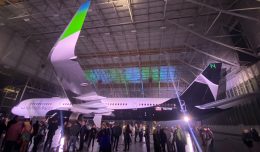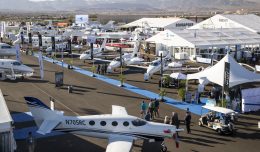This article originally appeared in the May/June issue of Airliners Magazine. Be sure to have a look at their site at www.airliners.tv, or follow them on Twitter at @AirlinersMag.
You can fly aboard this classic DC-7B at Teterboro Airport in New Jersey on August 12-14th. Book your tickets!
In a world when a person’s word can be broken and a handshake is no longer binding, there are people you can still count on. Carlos Gomez and Marc Wolff, by keeping Joe Kocour’s dream alive, are examples of such people. Joe is not with us today, but his beloved Eastern DC-7B is once again flying above us, and that, my friend, is a promise kept.
On America’s 234th birthday, July 4, 2010, former Eastern Air Lines DC-7B N836D took to the air at Opa-locka Airport in Southern Florida on its first post-restoration flight. Captain George Riley, First Officer Eduardo Blanco and Flight Engineer Carlos Gomez pronounced the 40-minute local flight very smooth and “uneventful.” The flight marked the culmination of a six-year restoration project and hopefully the start of a superstar airshow career for this one-of-a-kind aircraft. The story began when Carlos Gomez and Marc Wolff rescued N836D from almost certain scrapping at St. Paul’s Downtown Holman Field (STP) in 2004. Most aviation experts thought they had lost their minds but they have made good on their promise and restored the vintage airliner to her former glory.

Engines have been through their run ups, systems checked, Captain George Riley taxies to the active runway 9L at Opa-locka. (Photo by Bill Underwood)
One Man’s Dream
DC-7B N836D (c/n 45345) was delivered to Eastern Air Lines on January 23, 1958, just a few months prior to the advent of the jet age. The reign of Eastern’s fifty-strong DC-7B fleet was short, with the last aircraft being retired in October 1966. Most were sold to California Airmotive, which bought N836D in September 1965. Nomads, Inc., a Detroit based travel club bought the aircraft in 1966 but by 1971 it had been replaced by a Lockheed Electra and was parked at Detroit’s Metropolitan Wayne County Airport (DTW) awaiting sale. Joe Kocour, a St. Paul native, founded the Twentieth Century Travel Club and purchased N836D in 1972 with the intent of operating the travel club out of his hometown. For 32 years Joe Kocour kept his dream alive to get the DC-7B back in the air. He would occasionally run the engines, perform maintenance and move the aircraft around St. Paul’s Downtown Holman Field (STP) to keep it away from the flood prone Mississippi River. In November 2003 he passed his dream on to Carlos Gomez and Marc Wolff.
The Deal is Made and Work Begins
Carlos Gomez became aware of Joe’s DC-7B in 2003 and later that year, in concert with Marc and Marlene Wolff, formed Legendary Airliners with the express intent of purchasing and restoring the aircraft. Carlos is co-owner of Florida Air Transport (FAT) and had plenty of experience operating vintage Douglas propliners from his home base at Opa-locka Airport (OPF) in southern Florida. What made N836D so attractive to him was that it was the sole surviving DC-7 with an intact passenger interior. Carlos contacted Joe and a date was set in November 2003 for Carlos to inspect the aircraft. After spending a few hours on a very cold airport ramp, Carlos made Joe an offer and later that day they shook hands on a deal.
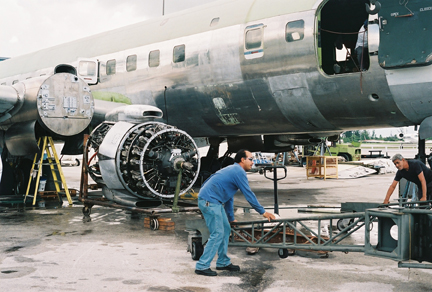
With #3 in position, gantry crane is made ready to hoist the engine into position. (Photo by Bill Underwood)
Carlos now had his airplane but starting work on the old airliner would have to wait for the end of the cold Minnesota winter. On May 22, 2004 Carlos, his father Martin and Marc’s father-in-law Larry Breuner, departed Miami for St Paul. The first order of business was to carefully inspect the aircraft and prepare a plan of action. The inspection confirmed what Carlos had determined on his initial inspection back in November: The aircraft was essentially sound but needed quite a bit of work before the flight to Florida could be undertaken.
After removing years of accumulated bird nests, the engines were successfully run at low power settings the week of June 13th. Over the next few weeks the engines were run at progressively higher power settings with no unexpected problems occurring. All fuel lines, oil lines, and fuel injection pumps were replaced. Control cables were lubricated and those that couldn’t be salvaged were replaced. The previous reports of massive main spar corrosion proved unfounded but the group did find that the outer wing panels had some corrosion. This was not unexpected and wasn’t severe enough to delay the ferry flight to Opa-locka where they would be replaced. The rudder was replaced with one that Joe Kocour donated and by the third week of June, the project was definitely coming together.
Up to this point things were looking very good for an early July departure to Florida, but this was not to be. During high-speed taxi testing on July 8th, the #4 engine experienced a master rod bearing failure, which required an engine replacement. The crew decided to pack up and head back to Florida to collect a replacement engine and take a much needed break. On Thursday, July 22nd, they were again heading north with a replacement engine and four props from DC-7BF, N381AA. An FAA airworthiness directive (AD) had been issued in 1982 for the inspection of DC-7 props for corrosion, and this obviously had never been completed on N836D. With the replacement engine and four AD compliant props the group arrived in St. Paul on Saturday July 24th. By sunset the new engine had been hung and was ready for testing.

Slow and careful, you don’t want to drop a 3350! (Photo by Bill Underwood)
By Sunday July 25th, testing of the #4 engine was complete and the group began the task of addressing a number of minor problems that needed correction prior to the ferry flight. The plan was to depart St. Paul for Atlanta the following Saturday morning. On Friday July 30th during engine testing, the #1 engine experienced a bearing failure, which necessitated another engine change. Another trip was made to Miami to collect a replacement engine and the
#1 engine was changed out on August 3rd and successfully tested the next day. Thankfully, this was the last engine change!
Successful Ferry Flight
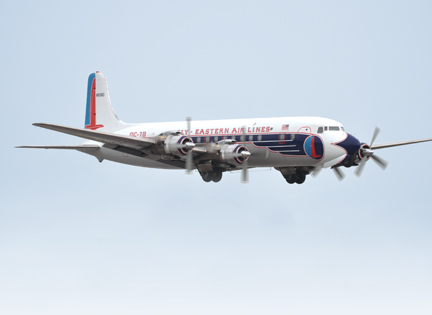
At 0900, Sunday, July 4th, 2010, the first post restoration flight tucks the gear on its maiden take-off! (Photo by Bill Underwood)
The flight crew arrived from Miami on Thursday August 5th and high-speed taxi tests were completed later that day. A ferry permit was issued and the old girl was just about ready to depart. Friday was used to tie up loose ends and N836D departed St Paul for Atlanta on Saturday August 7th on her first flight in over 32 years. In command of the flight was Captain Frank Moss with First Officer Saddy Barraza in the right seat and Carlos performing flight engineer duties. Four hours after departing St Paul, crew and airplane arrived safely at DeKalb-Peachtree Airport (PDK) near Atlanta. A large and enthusiastic group of former Eastern Air Lines employees greeted N836D and the crew on their arrival. After an overnight stop, the aircraft departed Dekalb-Peachtree Airport at 4:00pm Sunday, heading south to Opa-locka Airport in Southern Florida where she arrived two hours and fifty minutes later. Defying the skeptics who said it couldn’t be done, Carlos had the aircraft airworthy and ready for the ferry flight south in less than three months. It turned out getting the old airliner back in the air for the ferry flight to Opa-locka Airport would be the quickest part of the entire project.
Major Restoration
Restoration began in earnest in October 2004 and by February 2005 much of the interior had been removed and six sheet metal workers were laboring full time replacing corroded fuselage skin panels. Skin corrosion was worse than originally expected and eventually most of the upper fuselage was re-skinned. The #1 and #4 engines were removed for overhaul and the four props were returned to sister ship N381AA.
By June 2006 re-skinning of the left fuselage was complete and workers turned their attention to the right side of the aircraft. The outer wings were removed and replaced with ones salvaged from long time Chandler Memorial Airport (34AZ) resident DC-7C N6000V. The outer wings, along with a number of other valuable spares, had been donated by International Air Response in December 2005. IAR was moving their operations to Coolidge, Arizona and was in the process of scrapping much of their former fleet of vintage Douglas airliners at Chandler Memorial Airport near Phoenix. Work continued on the engines and props with six additional engines being purchased as spares.

This is an engineer’s eye view of N836D’s fully restored cockpit, looking as good as the day she rolled off the Douglas line at Santa Monica in 1958. This shot was captured moments before Captain George Riley entered the cockpit to take her up on a rainy July 4th morning. (Photo by William Wetmore/Njord Photography)
With the fuselage re-skinning effort completed, painting the aircraft in 1950’s era Eastern Air Lines colors began in August 2007. What a sight it was to see this aircraft return to her former glory. By February 2008 all four engines and overhauled props had been installed. The interior of the aircraft had been completely gutted and was finally ready for installation of wall panels, seats and carpeting. Lantal Textiles, a leading supplier of aircraft textiles and carpet, donated carpet and panel material for the project. Working with designers from Lantal, Carlos decided to replace the original green and cream interior colors with a gray and blue interior. The original seats could not be economically salvaged for flight use and more modern seats, donated by Quality Aircraft Interior, were refurbished and installed. The original seats have been placed in storage and will be available for reinstallation when the aircraft is retired to a museum at some time in the future. The two original lavatories were also beyond economic restoration and Carlos obtained two DC-9 lavatories from a local company scrapping out Northwest Airlines DC-9’s. They fit the DC-7B perfectly and period fixtures were salvaged from the original lavatories.
By November 2008, the exterior work was essentially complete, with Carlos and a small crew wrapping up work on the 60-seat interior. While classic airliner purists may be disappointed that the aircraft’s hat racks weren’t installed, the classic rear lounge was retained and included the original Plexiglas partition. Many of the original placards were restored by Atlantic Models who also refurbished the original fiberglass window frames. The cockpit was completely restored and will look as good as the day the aircraft rolled off the Douglas assembly line at Santa Monica!
Historical Flight Foundation (HFF) is Born

Portrait of most of the core group. From left to right, Roger Jarman from HFF, F.O. Eduardo Blanco, F.E. Carlos Gomez, Mechanic Martin Aguero, Captain George Riley, Carlos’ Dad, Martin Gomez, Mechanic Leo Cordero, Walter Gomez, Mechanic Porfirio Cornetero, and Marc Wolff. (Photo by Bill Wetmore)
By September 2009 restoration of the aircraft was essentially complete with all four engines having been successfully test run in July. Roger Jarman, owner of Atlantic Models, had been a frequent visitor to the FAT ramp since the arrival of N836D. It was during these visits Roger came to appreciate the truly unique nature of the aircraft that frequented the ramp. In a discussion with Carlos one day, they brainstormed the concept of painting these aircraft in various classic airline color schemes. Their timing was perfect when, in October 2007, the FAA issued a ruling that allowed historically significant aircraft to carry passengers. The program was developed to allow owners of these aircraft to generate funds for the preservation of their aircraft by offering flights to the general public. There are a number of groups offering flights on WW II bomber aircraft but the DC-7B would be the largest aircraft in the program.
The ruling stipulated that the aircraft had to be owned by a 501(c)3 tax exempt entity and Historical Flight Foundation (HFF) was born with the goal of preserving and operating classic prop airliners. HFF applied for tax-exempt status in January 2008 and received final approval in May 2008. N836D was transferred from Legendary Airliners LLC to HFF in December 2009. The DC-7B will be operated by HFF with flight crews and maintenance support provided under contract to Florida Air Transport.
The Original Plan
The original plan was to operate the aircraft under a FAR Part 91 exemption with maintenance and training performed in accordance with FAR Part 125. The Part 91 exemption would allow HFF to fly the general public on excursion flights departing and returning to the same airport.
The application for a Part 91 exemption was delivered to the FAA in April 2009 and, after a thorough and careful eleven month evaluation, an exemption allowing the flights was issued by the FAA on March 23, 2010. The exemption read, in part, as follows:
The FAA finds that a grant of exemption would be in the public interest and would provide an equivalent level of safety to that provided by current regulation.
The HFF is unique in that its Douglas Aircraft Co. DC-7B aircraft represents the only U.S. based, four engine, passenger prop-liner in operation today. With the advent of jet aircraft, most of the DC-7 aircraft disappeared from commercial airline service by the early 1970s. The majority of the DC-7’s were simply scrapped as they were seen as being un-economical to operate. In this unique case, the aircraft being operated by the HFF was still in its original passenger configuration as delivered to Eastern Air Lines in January 1958. Of the 112 DC-7 aircraft produced, this is the only surviving passenger configuration aircraft.
Signed: John W. McGraw, Acting Director, Flight Standards Service
A New Plan Evolves

Gantry crane, sheet metal, and windshield work progresses simultaneously. (Photo by Bill Underwood)
In addition to providing “flights to nowhere” to the general public, Roger and Carlos wanted to offer rides to HFF members on repositioning flights. After a number of discussions with the FAA, it was decided that the only way to do this would be to operate the aircraft in full compliance with FAR Part 125. Airshow flights would still be offered but by operating under Part 125, HFF would be able to offer city-to-city flights to members, very much like travel clubs have done in the past. While this was very good news, it also added many requirements that had to be satisfied prior to the first passenger carrying flight.
With high-speed taxi runs and additional engine tests completed in March, it was now time to tackle the additional Part 125 requirements. Working closely with the FAA’s South Florida Flight Standards District Office (FSDO), an accelerated plan of action was developed and work began to complete the items prior to the planned July 24th departure for Oshkosh. Roger obtained a Boeing 727 emergency slide, which was installed and successfully tested on May 28th. With the help of STG Aerospace, emergency floor lighting was installed. A traffic collision avoidance system (TCAS) unit was “borrowed” from DC-7BF N381AA and installation was completed in June. Batteries for an emergency lighting system were bought and installed but neither flight data nor voice recorders will be required because the aircraft will fly un-pressurized at altitudes less than 23,000 feet. Atlantic Models is fabricating the multitude of required placards and Roger is developing the required seatback emergency information card.
Carlos and Roger have been working closely with the South Florida FSDO since the DC-7B arrived at Opa-locka Airport in 2004. Logbooks, manuals, maintenance and flight plans have been thoroughly reviewed by the FAA along with a 3-day final inspection of the aircraft during the week of June 14th. Final details, including the requirement for an evacuation drill were completed and the post restoration flight was made on July 4th with Captain George Riley, First Officer Eduardo Blanco and Flight Engineer Carlos Gomez. After the flight, Carlos proclaimed “She wanted to keep going faster, and I had to keep pulling power back to slow her down. She wants to fly and we aim to let that happen!” Additional maintenance flights will be completed prior to the planned departure for Oshkosh on Saturday July 24th.
2010 Airshow Season
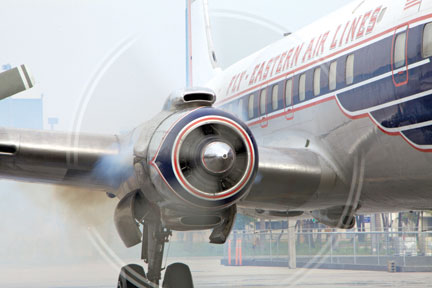
Number three starts up smoothly prior to the July 4th flight. (Photo by William Wetmore)
Julio Somarriba, Jr. of Wisetouch volunteered to polish the engine nacelles and wash/wax the airplane in preparation for her “coming out” party in Oshkosh. The 1,335 mile trip to Oshkosh will take about 5 hrs 40 minutes at a cruising speed of about 205 knots. En route altitude will vary from 3500-6500 feet and, depending on winds, a fuel stop may be required. Thirty seats are available to members for the flight to Oshkosh, where the airplane will be on display at AeroShell Square. On Wednesday July 28th at 2:30pm FAA Administrator Randy Babbit, Chesley “Sully” Sullenberger and Jeffrey Skiles of US Airways Flt 1549 fame will take a flight in N836D. Randy’s father was a pilot for Eastern Air Lines and actually logged time in N836D during his days with Eastern. In addition to the trip to EAA AirVenture in Oshkosh, N836D has been scheduled to appear at the Thunder of Michigan Airshow and at Teterboro Airport during the 2010 Airliners International Convention.
N836D was the first aircraft owned by the Nomads Flying Club of Detroit, Michigan. The club is still in business and currently offers members trips to worldwide destinations on a 92 seat Boeing 727-200. Roger has been in contact with the club and members have expressed an interest in flying from Oshkosh to Detroit after the airshow. It would be interesting to know if any of the original members of the club are planning on making the trip.
Long-Term HFF Vision
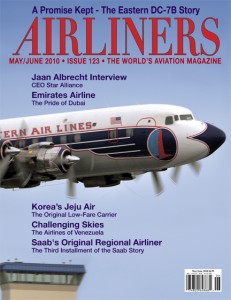
This article originally appeared in the May/June issue of Airliners Magazine. Be sure to have a look at their site at www.airliners.tv, or follow them on Twitter at @AirlinersMag.
The long-term plan for HFF calls for the purchase and restoration of a DC-3, DC-4, C-118/DC-6, M404 and CV-440. Plans also include a brick and mortar museum in the Miami area with Opa-locka Airport being the prime candidate for its location. The county has expressed an interest in helping develop an aviation destination for tourism and this museum would be the anchor for that effort. The group’s vision is for an art deco themed building with a roof top observation deck. This would allow museum visitors to watch the planes come and go on the ramp. HFF would invite the cargo operators to operate from this ramp thus creating a live trip back into the glory days of propliners. Individual HFF memberships may be obtained for $250 per year and entitle members to travel on the aircraft. For membership and other information regarding HFF, check out their website at http://www.historicalflightfoundation.com/
Carlos and Roger are well known in the propliner community and their friends have been very generous in support of this very exciting project. Donations are vital to a project like this and we should all be grateful for the generosity of these companies and others who have assisted in the restoration project. Operating a
DC-7B is a very expensive endeavor and both individual and corporation donations are always welcome.
Special Thanks
To all the individuals from the private sector, as well as the folks from large corporations who shared our vision of N836D. They provided much needed cash, products, labor and services to help make this dream a reality.
Amongst the large group not mentioned in the article, our heartfelt thanks go out to the Eastern Airlines Historical Foundation, Bill Hirsh, Roland Moore, Mike Clementi (World Fuel Services), Michelin Tires, Miami Executive Aviation, Conoco Phillips, Harry R. Lecorps (ASI, slides), Chris Sloan (2C Media), Turksair, Greg Drawbaugh, Michael Bolden, John Freeze, Francisco Agullo, Georg Von der Muehll literally too many to mention here, Bless you, and thank you, for without your support, this would not have been possible.


